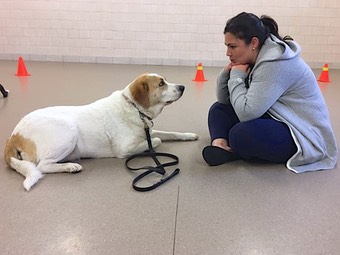
Behaviour modification always fascinates me. Getting temporary change to happen is easy. Many times when it relates to dogs, submission is mistaken for change especially when one uses quick fixes. True change takes time, patience and commitment. This is particularly the case when you are attempting to address behaviours on the more severe end of the spectrum. Aggression, and fear are probably the most serious ones. Interesting fact when it comes to our dogs, the later is more often than not, the cause of the former. People tend to forget that, instead relying on faulty practices rooted in dominance rhetoric in order to address the issues.
Dealing with a problem like fear aggression with dominance techniques may serve to suppress the signs of aggression for a time, however it rarely results in meaningful change. Usually, it simply masks the issue and creates bigger problems in the long run. For more on this see “Why Punishment Does Not Work"

Too often, we owners look for quick fixes. It is a sad reflection on our society. People want change and they want it immediately. Your dog pulls, use a training collar. Your dog barks in the yard, muzzle him. Your dog has a poor recall, buy a shock collar. While it is easy to fall into the trap of a quick fix, you need to be aware that quick fixes rarely bring long term changes. Most times, the tool used in a quick fix looses it’s effectiveness and therefore leads to a downward spiral where harsher and harsher methods need to be used in order to achieve the same results. If harsher methods are used, they can be very counterproductive to what you wish to accomplish.
Beware of quick fixes. I often get criticized on line for being reluctant to give “tips” to issues. Somebody writes, “my dog is reacting to other dogs on the walk, anybody have any tips for me to deal with this?”. My answer will always be “set up a one on one”. Why is this the case? It is not that I want your money. It is that I need to know why your dog is reacting. It is helpful for me to see the dynamics between you and your dog, to know how you react to your dog reacting, to understand what type of reaction your dog has, the antecedents before the reaction, what you have done to address the reactions thus far, who your dog is reacting to…the list can substantially grow. The problem with giving “tips” is that without knowing this information, I am just taking a shot in the dark and while the shot MAY work, it has an even greater likelihood of making things worse. You want “tips” use google and take your chances. For more on this, see, “On Tips, Tricks and Advice”. If you are unsure whether you need a one on one or class, use this reference guide.

Just one of the many reasons I am so proud of my training program is that it allows the opportunity for the growth of true change. A student can start with a one on one where a plan is developed to encourage behavioural change. The person can then move into classes. The courses are designed to give students a safe controlled environment to continue to work on the issues. The courses are supplemented by the evening training walks, the weekend group dog walks and online forums for each. The walks allow students the opportunity to get out and work with their dogs around other dogs and people. They also give students the opportunity to receive support. Your dog is being an ass, that is ok. You are surrounded by people who have been there. They understand what you are going through. As change happens, you can push the boundaries into higher levels of obedience as well as the My Dog is Awesome course. The courses are supported by course manuals that use evidence based research. If you wish, you can also partake in the many activities I encourage my students to become involved. The Pet Expo, the Santa Parade, Therapy Dog, school and community group presentations, chairty and organization events all offer the opportunity for your dog to develop and grow. For more on this see, “Why Enrol In Our Program”
All of this work takes time. It requires effort and commitment. However, when the change does start to occur, you can rest assured you are on the path to something beautiful. The success stories on this website are testaments to true change. None of them were quick fixes. All required patience and time but change did happen. The change led to happy dogs and even happier owners. Remember good dogs are made, they are not necessarily born that way.
So what should one look for when examining a behavior modification program?
1. It should be science based: classical and operant conditioning, counter conditioning, desensitization and learning theory should not just be buzz words used by the behavior consultant. As stated so often in other blog articles, if the behavior consultant or trainer is talking about dominance, alpha, and pack structure…look elsewhere.
2. The behavior modification should use evidence based practice: applied behaviour analysis, examining a behavior from an ABC perspective, and the humane hierarchy of ethical training should be cornerstones of any behavior techniques. If they are nonexistent, you may want to rethink who you are using.
Do your research, read testimonials, ask others and choose wisely. Behavior modification can be trying. It can be frustrating. The process is made even more complicated if you are given poor advice. Behavior modification takes patience and work. When it is done correctly, it is a beautiful thing.
For those of you who are interested in some “feel good” reading, check out the aforementioned “Success Stories”. Have a tissue handy, you will probably need one.
